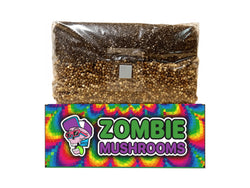⬇️ Prefer to listen instead? ⬇️
- Research shows turkey tail mushrooms boost immune function by raising natural killer cell activity.
- Extracts from turkey tail mushrooms (PSK) are used along with usual cancer treatments.
- Turkey tail mushrooms act as prebiotics. This helps feed good gut bacteria for better digestion.
- Stomach problems that are not bad and rare allergy issues are some possible side effects of using turkey tail mushrooms.
- Products you buy offer a set strength. Making your own lets you control all the ingredients.
Turkey tail mushrooms are now quite popular for their health benefits. But to get the most from them safely, you need to know how to use them right. This guide tells you about turkey tail benefits, how to use them, where to get them, and what to be careful about. This helps you use these mushrooms well.

What Are Turkey Tail Mushrooms?
Turkey tail mushrooms, known as Trametes versicolor, are common mushrooms with colorful rings like a wild turkey's tail. They grow on dead hardwood trees around the world, and people have used them for hundreds of years in Traditional Chinese Medicine (Yun Zhi) and Japanese Kampo medicine. Lately, science has shown they can help with health. Research shows they can boost the immune system, help gut bacteria, and even aid in cancer treatment. These mushrooms have strong compounds like PSP, PSK, beta-glucans, flavonoids, and triterpenoids. These all help support health.

Are Turkey Tail Mushrooms Edible?
You can eat turkey tail mushrooms, but not like regular mushrooms. They are not like shiitake or oyster mushrooms. Turkey tails are tough and feel like leather. They are built to last outdoors, not for eating meals. Their stiff structure makes them very hard to digest. You need to prepare them specially. This often means boiling them for a long time, grinding them into powder, or making extracts. It's better to use them in health preparations. This way, their helpful compounds can be taken out with heat or alcohol (Smith et al., 2002).

Texture and Taste Profile
Knowing how turkey tail mushrooms look and taste helps you know what to expect.
Texture
- Tough and leathery: They feel like thin, strong cardboard strips.
- Fibrous: And pulling a piece apart feels like tearing wood pulp.
- Strong: Cooking them longer doesn't make them much softer.
Taste
- Earthy and a bit sweet: They taste like a wet forest floor.
- A little bitter: This is true especially when brewed strongly.
- Not too strong: This means they mix well with tastes like ginger, cinnamon, or lemon.
You wouldn't cook a meal with them. But they can taste good when prepared the right way, like in a calming tea or rich broth.

How to Use Turkey Tail Mushrooms
You can get all the turkey tail mushroom benefits by using different ways to prepare them. This gets out the most helpful parts.
Making Turkey Tail Mushroom Tea
Making mushroom tea is a classic, nice way to use turkey tails. It's easy and works well.
Ingredients
- 3–5 dried turkey tail mushrooms or ¼ cup chopped
- 4 cups filtered water
- Optional: natural sweeteners or flavor enhancers like honey, lemon, or fresh ginger
Preparation
- Clean: Gently wipe mushrooms with a damp cloth to remove dirt.
- Chop: Break into small pieces. This makes it easier to get the compounds out.
- Simmer: Put mushrooms in water. Keep the heat low, and simmer for 1–3 hours.
- Strain: Pour through a fine mesh or cheesecloth to remove the solid bits.
- Flavor: Stir in ginger, honey, or citrus if you like.
Alternate Methods
- French Press Brew: Want an easier way to get the compounds out? Steep chopped mushrooms and loose tea for 45–60 minutes in a French press.
- Quick Simmer: Don't have much time? Simmer for 15–20 minutes to get a lighter tea.
Tip: Freeze extra tea in ice cube trays. This makes it simple to use small amounts later.
Creating Turkey Tail Mushroom Broth
Making broth is a good way to add turkey tail mushrooms to healthy meals.
Ingredients
- Dried or fresh turkey tail mushrooms
- Things for flavor: onion, garlic, carrots, celery, ginger
- Water
- Herbs and spices for taste
Preparation
- Put all ingredients in a stockpot.
- Simmer gently for 2–6 hours. This makes a liquid full of nutrients and flavor.
- Strain the broth and season it. Use it for soups, stews, or drink it alone to help digestion and immunity.
Storage: Keep broth in the fridge for up to 5 days. Or freeze it in small amounts for later use.
Using Turkey Tail Mushroom Powder
You can use turkey tail mushroom powder in many ways to add health benefits to your food.
Steps to Make Powder
- Dry turkey tails completely. Use a dehydrator or an oven (at 105°F–115°F).
- Grind the dried pieces into fine powder. Use a strong coffee grinder.
How to Use:
- Mix into smoothies, protein shakes, or hot drinks.
- Add to soups, stews, or bone broth.
- Mix into homemade snack bars, cookies, or energy bites.
- Add to oatmeal or yogurt for more health benefits.
Storage Tip: Keep powders in sealed containers away from heat and light. This keeps them strong.
Making Turkey Tail Mushroom Tinctures
Making a tincture is a way to get a lot of helpful compounds in a small amount.
Ingredients
- Dried turkey tail mushrooms cut into small pieces
- Strong alcohol (vodka or everclear)
Instructions
- Fill a jar with the cut mushrooms.
- Pour alcohol over them. Use 5 parts liquid for every 1 part mushroom.
- Close the jar tightly. Shake well and keep it in a cool, dark place for at least 2–4 weeks.
- Strain the liquid through cheesecloth. Put the liquid in dark glass bottles.
Double Extraction Method
- First, do the alcohol part.
- After straining, boil the leftover mushrooms in water.
- Mix the alcohol and water parts together. This gives you a tincture with many different compounds.
How Much to Use: Usually, you use 1–2 dropperfuls (30–60 drops) each day. But always read the label or ask an herbalist what to do.

DIY vs. Store-bought Options
You can make your own turkey tail products or buy them already made. What you choose depends on your life and what you want for your health.
Why Make Your Own
- You control how good it is and how much you use.
- It can save money over time.
- You can change the taste by adding other things.
Why Buy Ready-Made
- It's easy and saves time.
- You can be sure how strong it is, especially if they check for things like beta-glucans.
- Companies test carefully for bad stuff like mold, heavy metals, and pesticides.
Buying Tip: Check for things like USDA Organic labels. Also, look for proof that a separate lab tested it. This helps make sure what you buy is safe and good.

Turkey Tail Mushroom Benefits
Science now backs up many old uses for turkey tail mushrooms
Immune Support
Studies show compounds in turkey tail (PSP and PSK) greatly raise the activity of natural killer (NK) cells. This helps the immune system find and fight off germs and unhealthy cells (Ooi & Liu, 2000).
Gut Health
Turkey tail mushrooms are like natural food for good gut bacteria such as Bifidobacterium and Lactobacillus. This helps digestion work well and makes your immunity stronger.
Cancer Support
In Japan, PSK extracts are officially used along with regular cancer treatments for stomach, breast, and colon cancers (Kidd, 2000). They do not treat cancer alone, but they help people live longer when used with chemotherapy.
Antioxidant Properties
Turkey tail mushrooms have many polyphenols and flavonoids. These fight oxidation. This helps stop damage from free radicals, which are linked to getting older, swelling inside the body, and long-term sickness.
Potential Viral Defense
Early studies suggest that turkey tail extracts might help the immune system fight viruses better. But scientists need to do more research to know for sure if this works for different types of viruses.

Sourcing Turkey Tail Mushrooms
Foraging
If you like being outside, you might find turkey tail mushrooms yourself
- How to Spot Them: Look for colorful rings on top. Also, check for small holes (not lines) underneath.
- Safety: Only pick them from places far from bug sprays, roads, or factories.
- Ask an Expert: If you are not sure, ask someone who knows about finding mushrooms or check a guide book. This helps you avoid mushrooms that look similar but are not turkey tail (Stereum ostere).
Buying
Want to buy from places you trust? Some good places are
- Health food stores (in person or online)
- Local herb shops
- Mushroom farms that are known to be good
What to Look For
- Organic label
- Clear details about where they came from
- Test results showing they checked for heavy metals and bad stuff

Safety Considerations and Potential Side Effects
People generally think turkey tail mushrooms are safe. But know about possible side effects. This helps you use them safely.
Possible Side Effects
- Stomach problems that are not bad (like bloating, gas) when you first start using them.
- Allergy problems that do not happen often (like a rash or breathing issues) (Guggenheim et al., 2014).
Things to Be Careful About
- Start using them a little bit at a time.
- If you are pregnant or feeding a baby, ask your doctor before using them.
- Be careful if you have illnesses where your body attacks itself, or if you take medicine to stop your body from rejecting things or to stop blood clots.

Turkey tail mushrooms offer a strong mix of benefits. They help your immune system, feed good gut bacteria, and fight oxidation. You can make your own teas and tinctures, or buy powders and extracts. Knowing how to use them right helps you get their full health benefits safely and well. What way will you try first?
Citations
-
Guggenheim, A. G., Wright, K. M., & Zwickey, H. L. (2014). Immune Modulation From Five Major Mushrooms: Application to Integrative Oncology. Integrative Medicine: A Clinician's Journal (IMCJ), 13(1), 32–44.
-
Kidd, P. M. (2000). The use of mushroom glucans and proteoglycans in cancer treatment. Alternative Medicine Review, 5(1), 4–27.
-
Ooi, V. E., & Liu, F. (2000). Immunomodulation and anti-cancer activity of polysaccharide-protein complexes. Frontiers in Bioscience, 5, d141–151.
-
Smith, J. E., Rowan, N. J., & Sullivan, R. (2002). Medicinal mushrooms: Their therapeutic properties and current medical usage with special emphasis on cancer treatments. University of Strathclyde and Cancer Research UK.




